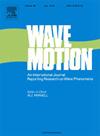在水锤波上
IF 2.5
3区 物理与天体物理
Q2 ACOUSTICS
引用次数: 0
摘要
利用Di Nucci et al., 2024a, 2024b中提出的波动方程研究了水锤波,即有限振幅压力波在管道流动中的低频、低马赫数传播。该波动方程类似于线性阻尼波动方程,是基于准不可压缩Reynolds平均Navier-Stokes方程的湍流黏性模型。由于熵产生引起的温度变化被忽略,并施加绝热条件。还提供了用于推导波动方程的假设的其他见解。针对压力波在充液管道(无空化)中的一维传播问题,利用文献中的实验数据对波动方程的解析解进行了检验。简化假设对定量结果的影响似乎很小;因此,在复制水锤波特性(包括阻尼、平滑和最大压力峰值)方面达到了很高的精度。结果表明:雷诺数对水锤波传播的影响最小,即涡度场对水锤波的流动特性影响不显著;对熵的产生以及在水锤波传播中占主导地位的无量纲数所起的作用给予了更深入的关注。阻尼特性也被确定。本文章由计算机程序翻译,如有差异,请以英文原文为准。

On water hammer waves
Water hammer waves, i.e., low-frequency, low-Mach number propagation of finite-amplitude pressure waves in pipe flow, are investigated by means of the wave equation proposed in Di Nucci et al., 2024a, 2024b. The wave equation, resembling a linear damped wave equation, comes from the turbulent-viscosity model based on the quasi-incompressible Reynolds Averaged Navier–Stokes equations. Changes in temperature due to entropy production are neglected, and adiabatic conditions are imposed. Additional insights on the assumptions used to derive the wave equation are also provided. Focusing on the one-dimensional propagation of pressure waves in liquid-filled pipes (without cavitation), analytical solution of the wave equation is tested against experimental data available from the literature. The impact of the simplifying assumptions on the quantitative outcomes appears to be small; therefore a good level of accuracy in replicating water hammer wave characteristics (including damping, smoothing, and maximum pressure peak) is achieved. Results show that the Reynolds number has minimal influence on water hammer wave propagation, i.e., the vorticity field has no remarkable effect on flow behavior. Deeper attention is given to entropy production, and to the role played by the dimensionless number which is identified as predominant in water hammer wave propagation. Damping properties are also determined.
求助全文
通过发布文献求助,成功后即可免费获取论文全文。
去求助
来源期刊

Wave Motion
物理-力学
CiteScore
4.10
自引率
8.30%
发文量
118
审稿时长
3 months
期刊介绍:
Wave Motion is devoted to the cross fertilization of ideas, and to stimulating interaction between workers in various research areas in which wave propagation phenomena play a dominant role. The description and analysis of wave propagation phenomena provides a unifying thread connecting diverse areas of engineering and the physical sciences such as acoustics, optics, geophysics, seismology, electromagnetic theory, solid and fluid mechanics.
The journal publishes papers on analytical, numerical and experimental methods. Papers that address fundamentally new topics in wave phenomena or develop wave propagation methods for solving direct and inverse problems are of interest to the journal.
 求助内容:
求助内容: 应助结果提醒方式:
应助结果提醒方式:


